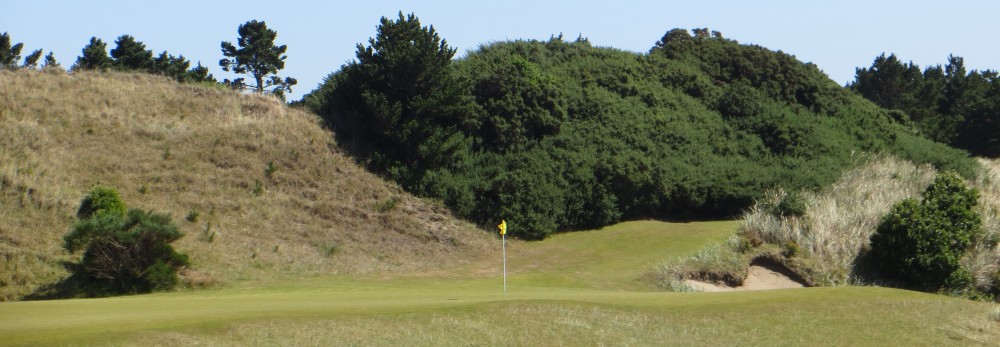Ireland is a country that boasts over 45 links golf courses and Royal County Down is undoubtedly the crown jewel of them all in the mind of those who have had the privilege to play it. The course camps on dramatic sand dunes above the town of Newcastle. The high vistas of the course provide some of the most majestic views in Ireland of this small rural town set at the foot of the Mountains of Mourne along the shores of Dundrum Bay and the Irish Sea. To borrow from the English golf writer Peter Dobereiner’s descriptive in the course yardage book, “The links of Newcastle are exhilarating even without a club in your hand…….As a backdrop, the Mountains of Mourne loom heavily against the sky, subtly changing color under the play of sunshine and shade just as the Irish sea switches its mood. Spice the picture with a hint of peat smoke in the wind and you have a setting which all the billions of property developers could never reproduce. The strip of dune land was 90% along the road to being a golf course before the game was ever invented. All it ever needed from the hand of man was a minimum of adjustment…… And all it needs now is restraint from the hand of man.”
The original routing of Royal County Down was done in 1889 by Old Tom Morris, who erroneously gets credit for the current course design, since most of his routing was abandoned about a decade later. The course we see today was the result of the diligent work of a club member, George Combe, in the early 1900’s. Much like Oakmont or Merion built around the same time, this incredible course was not the work of a famous course architect but rather an obsessive work in progress of a talented golfer and member of the club who understood the unique topography and wind conditions of this area and produced a series of holes that would take full advantage of both to create a unique tactical challenge. Subsequent modifications were done to the course by the renowned architect Harry Colt in the 1920’s when he modified some green settings and created the famous 4th and 9th holes which are two of the most celebrated on the course today. In 2005 further renovations were done by English architect Donald Steel and the 16th hole got a major makeover strengthening the finish of this magnificent layout. But it is really the work of Combe that is most responsible for these championship links that have so admirably stood the test of time. The impression most people have of this course after their first walk is that it is unfair and somewhat capricious. At 6600 yards in a howling Irish breeze with only 3 par fours under 400 yards I can understand how they would say that. The totally blind tee shots required on 2, 5, 6, 9, and 11 would never be presented by an architect building the course today. There are also a plethora of blind or semi-blind shots into the green complexes depending on the angle from which you are approaching the green. But as a wise old Scotsman once said, they are only blind the first time you play them and they do give the course a somewhat arbitrary characteristic that you can enjoy if you embrace it.
The fairways are narrow ribbons strung among some of the most impressive sand dunes in all of Ireland. The sides of these dunes are covered with purple heather and that nasty golden gorse that you so often see in Scotland but rarely experience on the Emerald Isle. Shots hit or blown off line can suffer what seems like an arbitrary punitive fate as a result but it is just the sticky rub of the green. The landing areas off the tee and into the greens have very distinct slopes and collection areas so picking the right club and the right line to end up in a position of tactical advantage is at a premium. Hiring an experienced caddy to be on your shoulder with local knowledge is a really wise investment.
The bunkers at Royal County Down are probably it’s most famous calling card. They are deep, cavernous sharply angled pits with native sea grasses growing over the top edges like intimidating Groucho eye brows. In many ways the generous bunkering is what makes this course a tactical gem. As with most links course that experience strong winds of varying directions, the positioning of a particular bunker can go from a benign visual hurdle one day to a heart stopping forced carry the next. Tactical positioning of the tee ball and the approach shots makes the game a bit of a chess match with the course and the daily elements. The greens are the least discussed feature of the course but in some ways the most important to consider. Similar to the Pinehurst 2, many of these greens are domed with fall off shoulders that feed a shot without sufficient conviction off into grassy hollows or sand pits from which it will be a serious challenge to get up and down. The low running recovery pitch will get major use, often times beginning away from the pin letting the slope and breeze bring the ball back to your target. There is plenty of slope in these greens-some obvious and some subtle-that make reading the greens for pace and break a huge challenge. Again, an experienced caddy can be invaluable in this regard.
For all the visual shock and awe you find on this course, it remains eminently playable and a place where you can shoot a good score if you keep your wits about you. It will ruthlessly punish impatient course management especially from players trying to do play shots that are clearly out of their skill set. But it provides wonderful opportunities to recover with clever tactical options for a player with a creative imagination and sound judgment. As with all links courses the ground is your friend, especially when the wind is up, so hitting bump and run approaches on the proper line can give you scoring opportunities you would not expect. When this day is over your mind will be as exhausted as your arms and shoulders, but if you have played well and won your Nassau bet there is a very gratifying Guinness with a large head awaiting you in the bar. Royal County Down has never hosted an Open Championship, mostly because of the obscure location and logistical challenge it would present to getting 20,000 people a day to the course. But it has had it’s share of prestigious and memorable championships over the years. The Senior Open Championship was hosted here from 2000 through 2002 and it attracted the likes of Nicklaus, Palmer, Player and Watson. After playing here, Watson put the first 15 holes at Royal County Down at the tops of his favorites list. The 2007 Walker Cup was a nail biter affair between some of the strongest amateurs in the world. The U.S. team that prevailed 12.5 to 11.5 included Rickie Fowler, Dustin Johnson, and Webb Simpson all of whom are destined to become household names on the PGA Tour.
Royal County Down has the golf pedigree to provide what the famous golf writer Herbert Warren Wind once said was “the sternest examination of golf I have ever taken”. Bernard Darwin golf writer and a top line amateur in his own right wrote that the golf here is “the kind of golf that people play in their most ecstatic dreams.” If you approach playing here with an open mind and a spirited resolve, you too will come away with a scrapbook of special golf memories from playing one of the finest links courses in the world. Newcastle, County Down Northern Ireland Architect: George Combe (1900-1910) Tees Par Yardage Rating Slope Medal 71 6878 74 131 Stableford 71 6675 73 126 (Click here to review Royal Country Down hole-by-hole descriptions)









